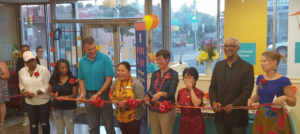Graphic Design and Gentrification: Is There A Link?: Part 3
Graphic Design and Gentrification: Is There A Link?: Part 1
Graphic Design and Gentrification: Is There A Link?: Part 2
Economics and Culture as Markers for Gentrification
It is no secret that the word ‘Gentrification’ is not viewed as positive. However, a recent report says that its not as bad as we think. A national study by the Federal Reserve Bank of Philadelphia suggests that gentrification creates some important benefits for original residents who stay such as less exposure to neighborhood poverty and increased home values. However, it also says that most of the original residents still move. In addition, there is a negative health impact on vulnerable communities that are displaced according to The Center for Disease Control (CDC).
An area of study that the report does not cover is culture. Rachel Garland, managing attorney of Community Legal Services’ (CLS) Housing Unit in Philadelphia, highlights this issue:
“Gentrification and displacement have severe ramifications, both for those forced to move out of neighborhoods and for those who are able to stay…Those who move struggle with the sense that they were forced out of their neighborhoods that they helped to build to make way for newcomers who have no connection or investment in the neighborhood. For those who stay, there is a loss of cultural history and memory…Those who stay watch their neighborhoods change drastically around them and have to contend with new neighbors and businesses who do not share the same cultural history, nor participate in the same social and cultural fabric.”
What does a loss of cultural history and memory look like? The Spring Garden section of North Philly gentrified twenty years ago. Near Spring Garden is Francisville, a small poor and working class section of Black and Latinx residents. Early Sunday mornings were typically filled with choir and worship music coming from nearby African American churches. I have relatives and friends who once attended churches in this area. I heard rumors that the new residents, who were not religious, complained about the noise. Religion is very important to most African Americans. Immediately involving civic and law authorities does not build good relationships with the original residents. The new residents could have simply asked their neighbors about it. Instead, they sent the police to ask the churches to close their windows.
Sometimes, the only thing a group with low social capital owns is their culture. Although the neighborhood network may be limited as stated in Part 2 of this commentary, culture permeates more of the neighborhood than outsiders realize. When one thinks of cultural expressions, food, fashion, dance and language come to mind. But what is overlooked is interpersonal relationships, money, family, business, possessions, religion, health, etc. Some of these elements are altered and even destroyed when people are displaced or when new residents demand some kind of change.
Economic Models of Gentrification
Here are three stories that point to economics as the basis for positive gentrification. Click the links to read more because the articles try to take a balanced view:
- New York City’s Chelsea Neighborhood:“ A report commissioned by the city and released in May studied the effects of gentrification on public housing residents and found benefits like safer streets and higher performing schools and students for those in wealthier settings. Coexistence, the researchers found, also led to higher annual earnings for public housing households in high-income areas than their counterparts in poor neighborhoods.”
- Washington D.C.’s Columbia Heights Neighborhood:“ The area is thriving as a result of the facade improvements… although some small businesses went under, most were able to hang on by adapting to the neighborhoods’ new population.”
- Cincinnati’s Washington Park Neighborhood:“ Due to earlier population loss, the rehab has avoided the usual arguments about gentrification: There was almost no one to drive out. “We were able to do this because everything was boarded up and hardly anyone was living there.”
I am not endorsing the conclusion of these stories. Economics is important but I do not believe it is the only one indicator of a community’s health.
The Importance of Culture

The Community Tool Box is a good start to understanding culture and people. A public service of the University of Kansas, it is managed by the KU Center for Community Health and Development. They have 46 online chapters dealing with community building and culture. In Chapter 27, they recognize that the world is growing more multicultural. In order to build diverse communities that can respond to emerging dilemmas, it means establishing relationships with people from cultures other than our own and building strong alliances. If different groups work together, they will be more effective in reaching common goals instead of in isolation.
Bringing vulnerable groups into the center of civic activity can provide fresh perspectives and shed new light on problems that others do not see. This recognizes that each group has unique cultural strengths and perspectives that the larger community can benefit from.
This is the part that is often missing in discussions about gentrification.
Economics are important for a group’s ability to live. But culture is the fuel that gives people, especially those most vulnerable, strength to endure uncertainty and hardships. Culture is rooted in routine and remembrance to give group identity longevity, purpose and posterity. When this is displaced, people, especially vulnerable groups, feel like they have lost a big part of themselves.
A Third Way?

Can an economic model be developed that encourages the original residents to stay, uses graphic design and advertising to preserve their culture while inviting new residents to embrace the community?
 The Exchange is an initiative of the Oxford Circle Christian Community Development Association (OCCCDA). They focus on the Oxford Circle neighborhood which is the most diverse in Philadelphia. OCCCDA develops programs that revolve around family, community and economic development. The Exchange, a multi-purpose space that encompasses a thrift store, community space for classes and rental space, celebrated its grand opening in 2018. All used merchandise is donated by the community for the purpose of employing local residents and raising money for their programs.
The Exchange is an initiative of the Oxford Circle Christian Community Development Association (OCCCDA). They focus on the Oxford Circle neighborhood which is the most diverse in Philadelphia. OCCCDA develops programs that revolve around family, community and economic development. The Exchange, a multi-purpose space that encompasses a thrift store, community space for classes and rental space, celebrated its grand opening in 2018. All used merchandise is donated by the community for the purpose of employing local residents and raising money for their programs.
Although OCCCDA is not directly engaging gentrification, they are attempting to create sustainable economic initiatives that support long term residents, welcome new residents and harnesses civic influence. They are helping unite ethnic businesses along Castor Avenue with dreams of the area becoming a cultural hub.
I created the branding for The Exchange and continue to be involved through graphic design and marketing. Click here to see my branding work.
It is clear that gentrification favors those with social, economic and political capital. They have the privilege of using their cultural values as the dominant expression for influence and impact for their own ends. But respecting the culture of those who are already living there requires humility, patience and collaboration. Graphic Design has been used to combat other social issues. Why should gentrification be ignored?
What do you think?